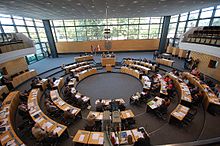Landtag of Thuringia
| Landtag of Thuringia | |
|---|---|
 |
|
| Type | |
| Type | |
| Leadership | |
|
President
|
|
| Structure | |
| Seats | 91 |
 |
|
|
Political groups
|
Opposition parties |
| Elections | |
|
Last election
|
14 September 2014 |
|
Next election
|
2019 or earlier |
| Meeting place | |
 |
|
| The Chamber of the Landtag of Thuringia (inside) | |
| Website | |
| www.thueringer-landtag.de | |
Government (47)
Opposition parties
The Landtag of Thuringia is the parliament of the German federal state of Thuringia. It convenes in Erfurt and currently consists of 91 members of five Parties. According to the free state's constitution, the primary functions of the Landtag are to pass laws, elect the Minister-President and control the government of Thuringia.
Elections are held every five years using the German Mixed-member proportional representation (MMP) system, with an election threshold of 5% vote share to receive any seats. All German citizens 18 years of age or older living in Thuringia are entitled to vote. If a party wins more constituency seats than its overall share of the vote, the overall size of the Landtag increases because of these overhang and leveling mandates.
After the elections of 14 September 2014, the CDU is the largest party, but the left parties (Linke, SPD, Greens) hold a bare majority of seats (46 of 91) and are in coalition.
Controversially in December 2014, the Landtag elected first ever Left Party Minister-President, Bodo Ramelow. The Left Party is seen as the successor to the Socialist Unity Party (SED) that ruled former East Germany. Ramelow heads a left-leaning coalition consisting of his Left Party, the Social Democratic Party (SPD) and the Greens, a so-called "red-red-green" coalition.
...
Wikipedia
